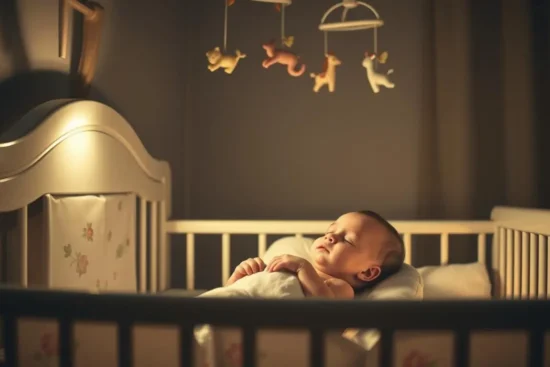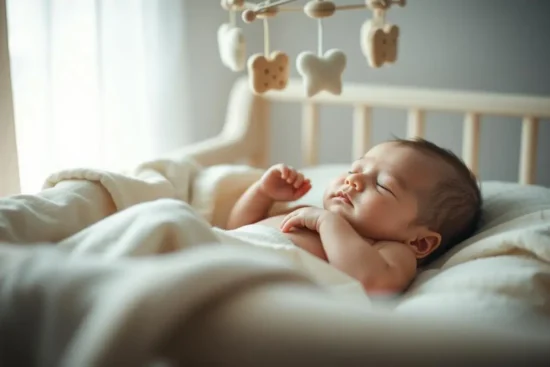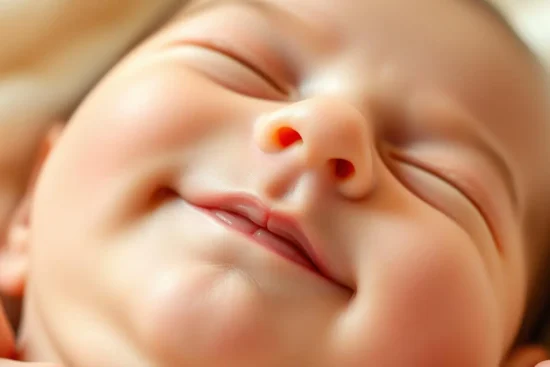
Parents often ask when babies can sleep with blankets. The American Academy of Pediatrics (AAP) offers guidelines for a safe sleep space. Knowing these rules is key to keeping your baby safe and sound.
It’s natural to want your baby to be cozy and comfy at night. But safety comes first. The AAP’s guidelines help lower the risk of SIDS and other dangers.
Thinking about when to let your baby use blankets? It’s important to follow the AAP’s advice. This way, you can make a safe and loving sleep area for your baby.
Key Takeaways
- Determine the right age for introducing blankets to your baby’s sleep environment
- Understand the AAP’s safe sleep guidelines for reducing SIDS risk
- Learn how to create a C environment for your baby
- Discover expert recommendations for transitioning from sleep sacks to blankets
- Find out how to choose the right blankets for your baby’s safety and comfort
- Get tips on maintaining safe sleep practices beyond infancy
Understanding Safe Sleep Basics for Infants
Creating a safe sleep space is key for babies. The American Academy of Pediatrics (AAP) offers aap safe sleep recommendations. These help parents make sure their baby’s sleep area is safe and healthy. A big part of this is sleep training, which means setting up a regular sleep routine and making the sleep area comfy.
The AAP says a safe sleep area should have a firm, flat mattress and a sheet that fits tight. Soft things like blankets and pillows should be kept away because they can raise the risk of SIDS. The AAP also suggests that babies sleep in the same room as their parents but in their own crib or bassinet.
Current AAP Safe Sleep Guidelines
The AAP’s safe sleep rules are all about a safe sleep space and give parents tips. These rules include:
- Placing the baby on their back to sleep
- Using a firm, flat mattress and a tight-fitting sheet
- Avoiding soft objects, such as blankets and pillows
- Room-sharing, where the baby sleeps in the same room as the parents
Why Blankets Pose Risks for Young Babies
Blankets can be very risky for young babies because they can up the risk of SIDS. The AAP says to stay away from blankets and soft things in the sleep area until the baby is at least 12 months old.

The Importance of Sleep Environment Safety
A safe sleep area is vital for babies. By sticking to the AAP’s safe sleep rules and making a comfy sleep space, parents can lower the risk of SIDS. Sleep training is also key. It helps set up a regular sleep routine and promotes good sleep habits.
When Can Babies Sleep with Blankets: Expert Recommendations
As a parent, you might wonder when can babies sleep with blankets. The American Academy of Pediatrics (AAP) advises against blankets for babies under 12 to 18 months. This is because blankets can be a suffocation risk for young ones. For a 1 year old baby, it’s key to check their growth and sleep habits before adding blankets.
Experts say to think about these points when deciding when can babies sleep with blankets:
- Age: Babies under 12 months should not sleep with blankets.
- Physical development: Babies should be able to roll over, sit up, and move their heads freely before sleeping with blankets.
- Sleep patterns: Babies should have a consistent sleep schedule and be able to self-soothe before introducing blankets.
Keeping your baby safe is crucial. Always talk to your pediatrician before adding blankets to your baby’s sleep area. They can give you advice tailored to your baby’s needs.

By looking at these points and following expert advice, you can make a safe sleep space for your 1 year old baby. This way, they can sleep well with blankets.
Signs Your Baby Is Ready for a Blanket
As your baby grows, it’s time to check if they’re ready for a blanket. This step is a big part of their sleeping journey. Look for signs like better motor skills and sleep patterns.
Some key signs to look out for include:
- Ability to roll over and move around comfortably
- Improved head and neck control
- Established sleep patterns, including baby sleeping through the night
Using a sleep sack is a great way to keep your baby safe and cozy. Make sure to pick a sleep sack that fits your baby’s age and size.
By watching your baby’s growth and using a sleep sack, you can make the switch to blankets smoothly. Always put your baby’s safety and comfort first when changing their sleep setup.
| Age | Sleep Pattern | Blanket Readiness |
|---|---|---|
| 4-6 months | Established sleep patterns | Not ready |
| 6-12 months | Improved sleep quality | Maybe ready |
| 1-2 years | Consistent sleep patterns | Ready |
Alternative Sleep Solutions Before Blanket Introduction
Parents often look for alternatives to blankets for their babies’ sleep. The sleep sack is a popular choice. It offers a safe, cozy space for infants to sleep. Sleep sacks prevent babies from getting tangled in blankets or overheating, making them great for sleep training.
Using a sleep sack has several benefits:
- Improved sleep quality: Sleep sacks help keep a baby’s body temperature right, leading to better sleep.
- Enhanced safety: They lower the risk of SIDS and other sleep dangers.
- Easy to use: Sleep sacks are simple to put on and take off, making them handy for parents.
Other alternatives like swaddles and sleep pods also offer comfort and security. They help babies fall asleep and stay asleep. These options help babies develop good sleep training habits early on.
Choosing the Right Sleep Sack for Your Baby
When it comes to baby sleeping safely, a sleep sack is key. It’s a wearable blanket that keeps your baby cozy without overheating. With many choices, picking the right one can be tough.
Think about the different types of sleep sacks. You can find:
- Lightweight sleep sacks for warm weather
- Thermal sleep sacks for colder climates
- Organic sleep sacks made from natural materials
Types of Sleep Sacks Available
When picking a sleep sack, size and TOG rating matter. The TOG rating shows how warm it is. Choose a TOG that fits your baby’s sleep area.
Size and TOG Rating Guide
Seasons also affect your choice. For warm months, go for a lightweight sleep sack. In cold months, a thermal one is best.
Seasonal Considerations
By considering these, you can pick the best sleep sack. This ensures your baby sleeps safely and comfortably. Always put your baby’s safety first and follow the maker’s use guidelines.
Safe Sleep Temperature Guidelines
Keeping your baby’s sleep area at the right temperature is key. The American Academy of Pediatrics (AAP) has aap safe sleep recommendations. They suggest keeping the room between 68-72°F (20-22°C) to avoid overheating.
Experts say a steady room temperature helps babies sleep better. Here are some tips to keep the temperature safe:
- Keep the room well-ventilated to prevent overheating
- Avoid overbundling or overdressing your baby
- Use light, breathable bedding and clothing
- Monitor the room temperature regularly
By following these tips and aap safe sleep recommendations, you can make a safe sleep space for your baby. A steady room temperature is vital for your baby’s health and happiness.
Transitioning from Sleep Sack to Blanket
Parents often wonder when to introduce blankets to their baby sleeping routine. Moving from a sleep sack to a blanket is a big step. Experts say it’s best to start around 12 to 18 months, when babies can sleep with blankets safely.
Before starting, check if your baby is ready. They should be able to move freely, roll over, and sit up without help. If they’re ready, you can begin the transition.
Step-by-Step Transition Process
- Start by introducing a lightweight blanket into the sleep sack
- Gradually increase the weight and thickness of the blanket over time
- Monitor your baby’s temperature and adjust the blanket as needed
Parents might face issues like overheating and tangled blankets. Keep the room at a good temperature. Use a blanket made for baby sleeping safety.
Common Challenges and Solutions
By following these steps and watching out for challenges, you can make the switch smoothly. This way, your baby can sleep with blankets safely and comfortably.
Best Types of Blankets for Toddlers
Choosing the right blanket for a 1 year old baby is key. It’s about safety and comfort. Soft, breathable blankets are perfect for a good night’s sleep.
For toddlers, natural materials are best. Cotton and bamboo are great. They’re soft, breathable, and safe for little ones.
Material Recommendations
- Cotton: A popular choice for baby blankets, cotton is breathable, soft, and easy to care for.
- Bamboo: Bamboo blankets are eco-friendly, hypoallergenic, and gentle on sensitive skin.
Size and Weight Considerations
Think about the blanket’s size and weight for a 1 year old baby. A lightweight blanket that’s big enough is best. It keeps the blanket from being too heavy or overwhelming.
Choosing the right blanket makes sleep safe and cozy for toddlers. It answers the question of when can babies sleep with blankets. And it helps your child sleep well.
When Can Babies Sleep with Other Comfort Items
Babies often get attached to comfort items like stuffed animals or pillows. It’s important to introduce these items safely and at the right time. This helps avoid SIDS or other sleep dangers. Sleep training helps babies learn to fall asleep on their own, but wait until they’re ready.
Deciding when can babies sleep with a stuffed animal depends on their age and development. Babies can start with a stuffed animal around 12-18 months. Make sure it’s soft, lightweight, and has no small parts. Also, keep the toy clean to avoid bacteria and mold.
Here are some tips for introducing comfort items safely: * Choose a soft, lightweight toy with no small parts or choking hazards * Ensure the toy is clean and well-maintained * Introduce the toy at a developmentally appropriate age (around 12-18 months) * Supervise your baby during sleep to ensure their safety * Consider sleep training to help your baby learn to self-soothe and fall asleep independently
| Age | Developmental Milestone | Introduction of Comfort Items |
|---|---|---|
| 12-18 months | Improved motor skills and hand-eye coordination | Soft, lightweight toys with no small parts or choking hazards |
| 18-24 months | Increased independence and self-soothing abilities | Pillows and other comfort items with proper supervision |
By following these guidelines and considering your baby’s individual development, you can help them sleep safely and comfortably with their favorite comfort items.
Maintaining Safe Sleep Practices Beyond Infancy
As a parent, it’s key to keep following aap safe sleep recommendations even when your baby grows up. Baby sleeping safely is vital for their health and growth. Make sure the room is safe and check it often.
A safe room setup can lower accident risks. Important things to think about include:
- Placing the bed away from windows and curtains
- Ensuring the room is well-ventilated and at a comfortable temperature
- Keeping the room dark and quiet to promote better sleep
Also, doing safety checks often is crucial to avoid accidents. Check the bed and area around it for dangers, like loose toys or cords. By following these tips and staying updated on aap safe sleep recommendations, you can make a safe sleep space for your toddler.
Remember, baby sleeping safely is a continuous effort for parents. By focusing on safe sleep, you help your child develop good sleep habits for life.
Room Setup Guidelines
To make a safe sleep area, follow these guidelines:
| Room Setup Element | Safe Sleep Recommendation |
|---|---|
| Bed Placement | Away from windows and curtains |
| Room Temperature | Comfortable and well-ventilated |
| Lighting | Dark and quiet to promote better sleep |
Ongoing Safety Checks
Regular safety checks are key to avoid accidents and keep a safe sleep space. This means:
- Inspecting the bed and area around it for dangers
- Ensuring the room is well-ventilated and at a comfortable temperature
- Keeping the room dark and quiet to promote better sleep
Common Parental Concerns Addressed
Many parents worry about their baby’s sleep, like using a sleep sack or blankets. They might think a sleep sack limits movement or overheats their baby. But, a good sleep sack can help with sleep training by offering a cozy, safe place for sleep.
Parents might also fret about switching from a sleep sack to blankets. But, with a slow and gentle move, this change can be easy. It’s key to pick a sleep sack that fits your baby right and follow the maker’s advice on how to use it.
Parents can also do more to help their baby sleep well. This includes setting a regular bedtime routine and making a sleep-friendly space. By tackling these worries and being proactive with sleep training, parents can help their baby sleep well for years to come.
Here are some important tips for parents:
- Choose a sleep sack that fits your baby’s age and size
- Follow the maker’s advice on use
- Set a consistent bedtime routine
- Make a sleep-friendly space
Conclusion
Introducing blankets to a baby’s sleep is a careful step. It’s a mix of safety and comfort. The American Academy of Pediatrics says to wait until they’re about 12 months old before using blankets.
Keeping your baby safe while they sleep is crucial. Knowing the dangers of blankets helps parents make their child’s sleep safe and sound. It’s important to be patient and watchful when moving from a sleep sack to a blanket.
Keep learning and listening to health experts as you parent. Your instincts are also very important. With the right steps, you can make a safe and cozy sleep space for your baby. Here’s to many peaceful nights for you and your little one.
FAQ
When can babies sleep with blankets?
The American Academy of Pediatrics (AAP) says babies should wait until they are 12 months old to sleep with blankets. Blankets can be a suffocation risk and increase the chance of Sudden Infant Death Syndrome (SIDS) for young babies. Use sleep sacks or wearable blankets until your baby is one year old.
Why do blankets pose risks for young babies?
Blankets can cover a baby’s face and head, leading to suffocation and SIDS risks. Young babies can’t move much and might get tangled in loose bedding, blocking their breathing. The AAP suggests a firm, flat sleep surface with no soft objects for a safe sleep area.
What are the current AAP safe sleep guidelines?
The AAP advises babies to sleep on their backs on a firm, flat surface like a crib or bassinet. The sleep area should have no soft objects, loose bedding, or bumpers. Use a sleep sack or wearable blanket until your baby is 12 months old. Keep the sleep area at a comfortable temperature.
How can I tell if my baby is ready for a blanket?
Look for these signs to know if your baby is ready for a blanket: – Physical development milestones: Your baby can roll over, push up, and move their head and limbs with control. – Motor skills assessment: Your baby can grip and manipulate objects with ease, reducing the risk of becoming entangled in loose bedding. – Sleep pattern indicators: Your baby is sleeping through the night consistently and has a stable sleep routine.
What are some alternative sleep solutions before introducing blankets?
Use sleep sacks or wearable blankets before introducing blankets. These provide warmth and comfort without the risks of loose bedding. Sleep sacks come in various sizes, materials, and TOG ratings to meet your baby’s growing needs.
How do I choose the right sleep sack for my baby?
Consider these when choosing a sleep sack: – Types of sleep sacks: There are different styles, including arms-free, two-way zippers, and integrated feet. – Size and TOG rating: Choose a sleep sack that fits your baby snugly and has the right TOG rating for the season. – Seasonal considerations: Use lighter sleep sacks for warmer months and heavier ones for colder months to keep a safe sleep temperature.
When can babies sleep with other comfort items, such as stuffed animals?
The AAP advises waiting until your baby is 12 months old before introducing soft objects, like stuffed animals, into their sleep area. Before 12 months, these items can be a suffocation and entanglement risk. After your baby turns one, you can introduce a small, lightweight stuffed animal or other comfort item to their sleep routine.







